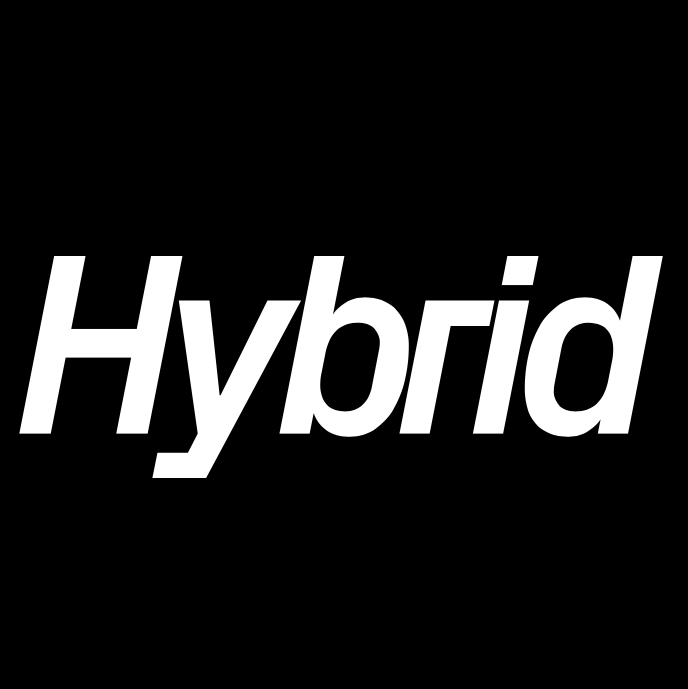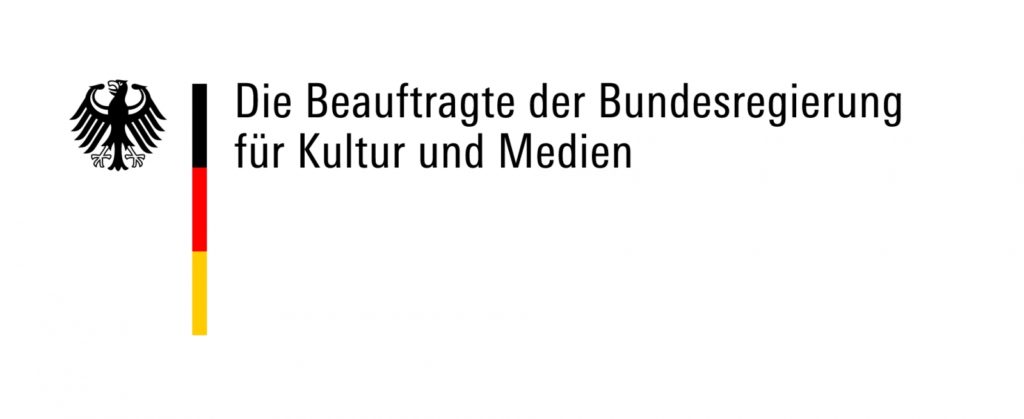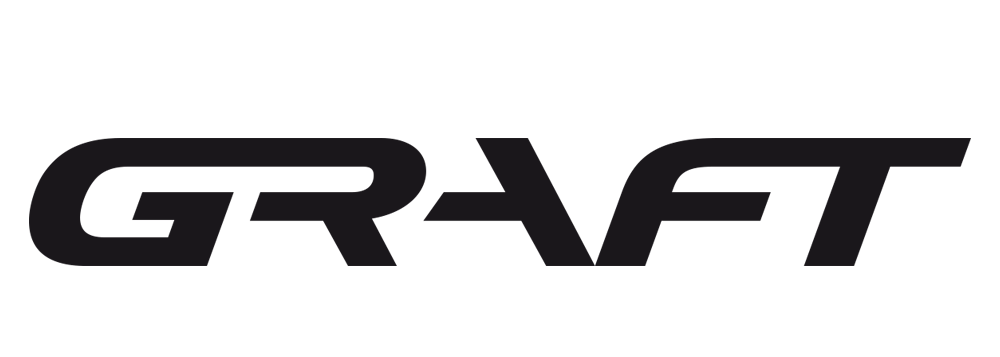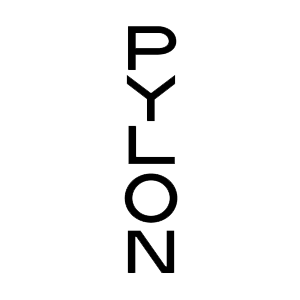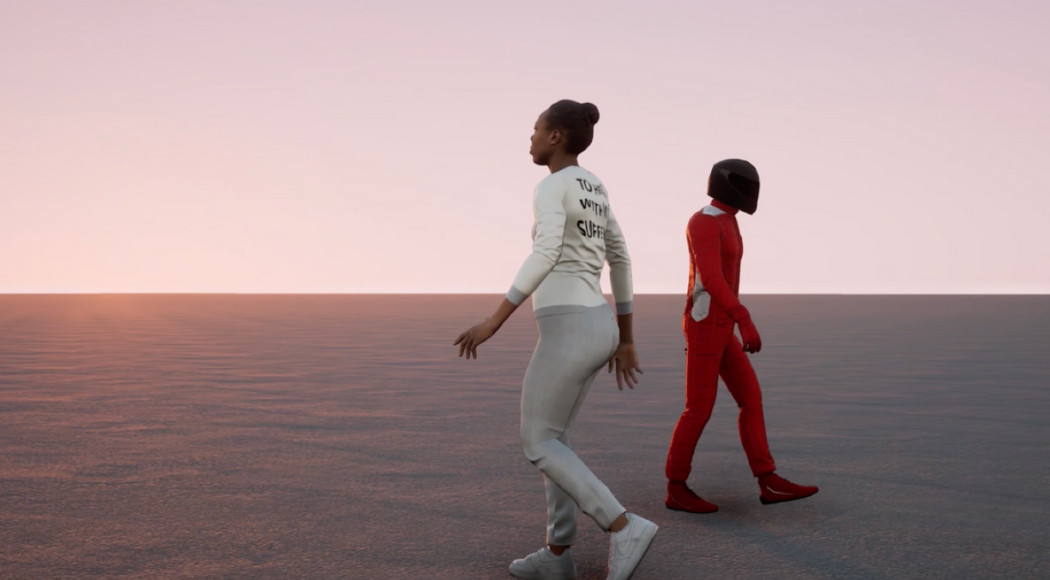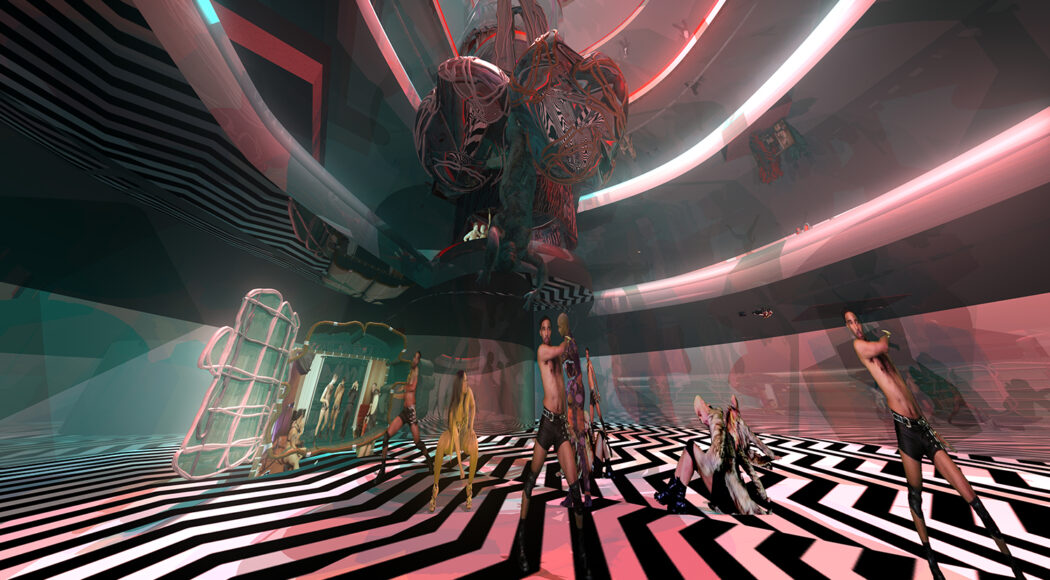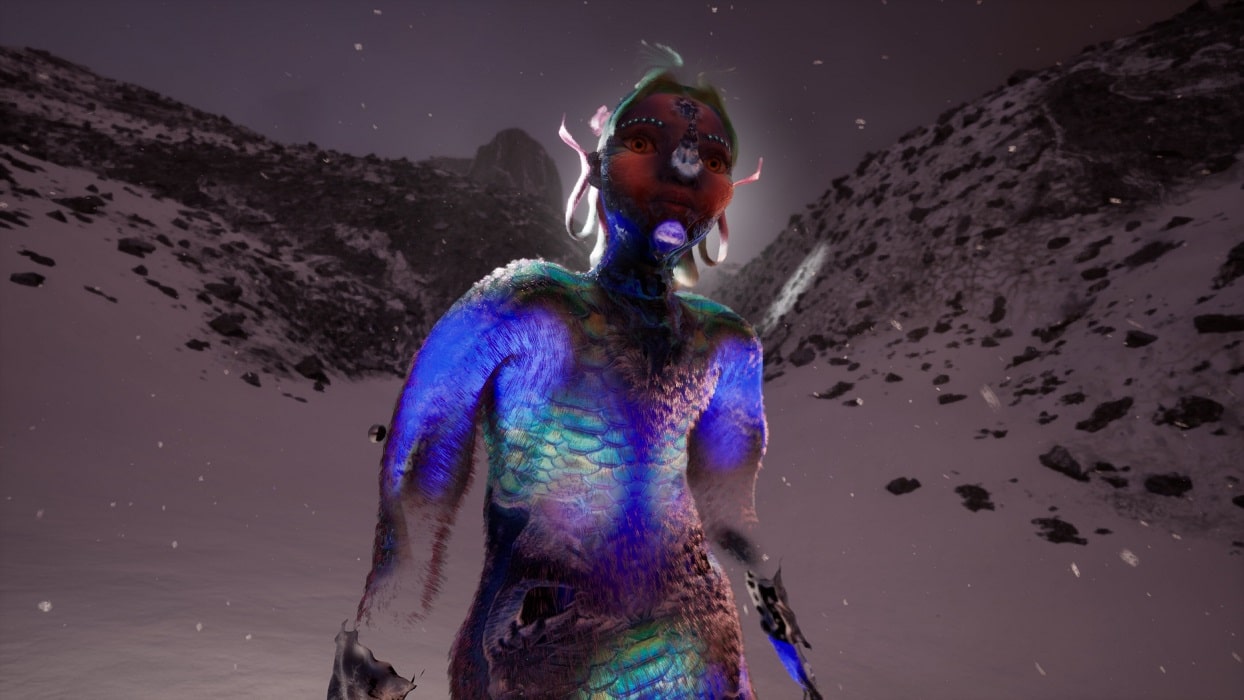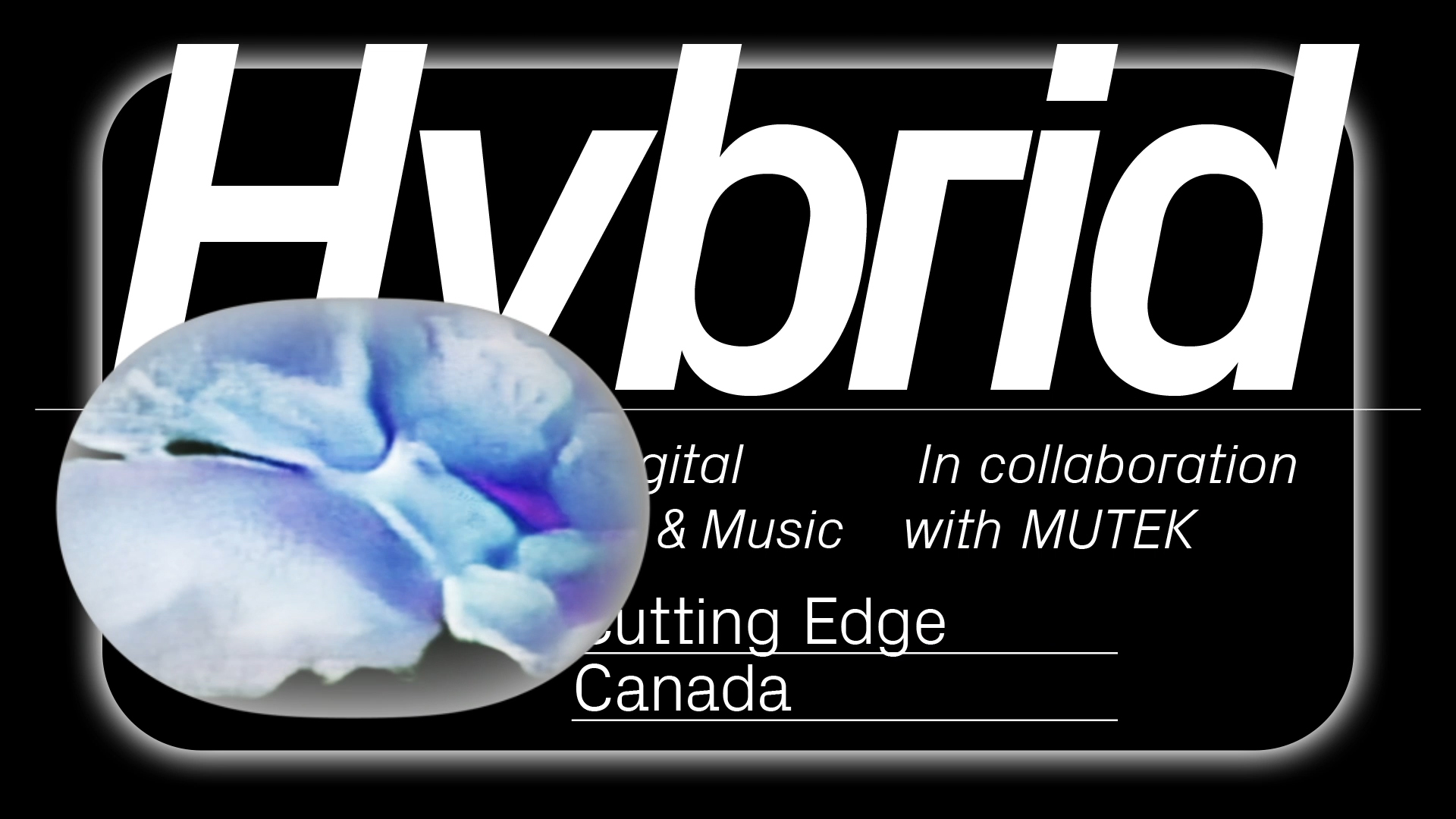HYBRID BOX extended
After three years the HYBRID Box has moved from its permanent location on the Festspielhaus front square in 2024 and has now become the HYBRID Box extended.
The HYBRID Box extended will make a temporary appearance in Dresden and beyond. In Dresden, the HYBRID Box extended 2024 will be represented by the three-part exhibition series “ERRATIC CURRENTS” in Dresden’s city center. For a total of three periods, ERRATIC CURRENTS will bring together works of art that build bridges to hidden, sometimes metaphysical territories. In the synthesis of digital precision and a dazzling indeterminacy created there, the echo of individual and collective identities can be perceived.
As part of the HYBRID Biennale (12.-27.10.2024), PYLON is presenting three special contemporary video works with ERRATIC CURRENTS at Kraftwerk Mitte 7 on three weekends each. In addition to works by Jacolby Satterwhite and Sondra Perry, a work by Martine Syms will also be shown.
The exhibition is open from Thursday to Saturday from 16:00-19:00.
The focus of this third part of the exhibition is the examination of the divergent currents that shape our self-image as individuals and societies today. The works presented invite visitors to immerse themselves in the fascinating but often contradictory realities created by the artists, in which human identities move between the poles of digitalization, virtualization and historical reminiscence.
One of the highlights of this series is the screening of the video work “DED” by Martine Syms from October 10-12, which also kicks off the “ERRATIC CURRENTS” series. The work explores the role of media and pop culture in the construction and preservation of identity. Syms questions how performativity and self-presentation are shaped by digital platforms and at the same time critically reflected upon. With humor and irony, she shows how the perception of authenticity is manipulated by the media.
“Blessed Avenue” by Jacolby Satterwhite will be on display from October 17-19 and explores the relationship between the body, technology and memory by merging dream worlds with digital spaces. The work uses 3D animations and personal fragments to re-contextualize familial memories in hyper-real landscapes. In doing so, Satterwhite poses fundamental identity questions about belonging, community and the possibility of redefining oneself within digital environments.
From 24-26 October, “IT’S IN THE GAME” by Sondra Perry addresses the commodification of black bodies and experiences of digital culture. Through the use of virtual reality elements and the deconstruction of sports video games, she shows how ethnically marked bodies are also exploited and instrumentalized in virtual space. Perry sheds light on the tension between digital representation and real exploitation and raises urgent questions about personal rights and their abuse in the digital sphere.
The HYBRID Box extended as part of the HYBRID Biennale sees itself as a laboratory and experimental space for subtle currents and collisions in the formation and demarcation of digital identities. At a time when the digital and the physical are increasingly merging, the exhibition explores the fragile but powerful transitions of identities shaped by both individual and collective experiences.
The works on display offer no easy answers or ready-made models for thought. Instead, they encourage reflection on how we locate ourselves and our society in the context of the ongoing digital transformation. The exhibition becomes a platform for questioning the impact of digital change on identities and the way we move through the world.
ERRATIC CURRENTS is a project by PYLON in cooperation with HELLERAU – European Center for the Arts as part of the HYBRID Biennale 2024.
The exhibition project is funded by the Cultural Foundation of the Free State of Saxony. The premises are partly provided by Wir Gestalten Dresden and Kreativ.Raum.Börse.
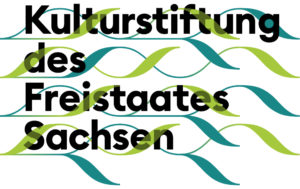
Previous exhibitions HYBRID BOX extended
Vitória Cribb is a digital artist based in Rio de Janeiro, Brazil. Cribb’s artwork reflects her inquiries and reflections on the impact of digital media on human consciousness. She explores various themes such as digital presence, surveillance, digital bodies, self- expression, and the psychological effects of the subconscious in cyberspace. In her recent works, she focuses on the immateriality of the digital realm and the impact of new visual information technologies on social behavior in contemporary society.
Cribb utilizes several digital tools, including 3D software modeling and augmented reality, to produce her artwork in the form of video essays. In her art, she analyzes topics such as surveillance and automated machine processes, while also exploring the connection between Black bodies and digital extractivism.
In her piece “Vigilante_extend” (2022), Cribb personalizes the “Vigilante” as an avatar that morphs when perceiving others through screens. The avatar is depicted as a woman surrounded by giant eyes and ears, with her own eyeball being a hollow, mirrored surface. The avatar symbolizes the impact of digital media on human consciousness, highlighting how technology has changed the way we perceive ourselves and others.
Cribb’s creative journey started in the late 1990s when gaming was on the rise. Her father introduced her and her sister to computer games at a young age, which sparked her creativity. During her teenage years, she found inspiration in music videos that greatly influenced her artistic interests. As someone who grew up with the internet, Cribb understands the importance of our digital footprint and being mindful of where our personal information goes. She is cautious about accepting terms and conditions that aren’t well understood and remains vigilant regarding data usage. Cribb emphasizes the significance of data privacy in the digital age.
Artist and computer scientist Lauren Lee McCarthy is fascinated by how humans are adapting to the ubiquity of artificial intelligence and the accompanying surveillance, automation, and algorithmic living. She believes that the systems we construct, both technical and social, influence the way we coexist and interact. McCarthy’s interest in the convergence of art and technology started during her undergraduate years at the Massachusetts Institute of Technology (MIT).
Most of McCarthy’s work focuses on interactive performances that invite viewers to engage with her and with AI technology. In her “Lauren” series, for instance, she plays the role of a virtual personal assistant for up to a week in homes equipped with bespoke networked smart devices. This gives her control over switches, door locks, faucets, and various electronic appliances. Her endeavor to outperform AI raises inquiries about the tension between intimacy and privacy, convenience versus agency, and the role of human labor in the future of automation.
McCarthy draws inspiration from our relationship with technology, where consent often appears lacking. She takes into account the introduction of Alexa into households, followed by unrequested updates altering its functionality. Or the intricate and extensive terms of service agreements, which hardly anyone reads before clicking ‘accept.’ These are deliberate tactics aimed at impeding informed consent. McCarthy considers how she can approach things differently in her projects. For instance, in the LAUREN project, she takes ample time to explain each component of the system, seeking approval for the placement of cameras or microphones. She ensures that homeowners retain the autonomy to consent or decline. Furthermore, she demonstrates how to deactivate or cover these devices, or inform them they can command, ‘LAUREN shut down,’ prompting an immediate cessation of operations. She delineates what will happen with their data and what won’t.
Shifting Horizons – Questioning the Future
The exhibition “Shifting Horizons – Questioning the Future” is the second installment of PYLON’s representation in the city space. It features the thought-provoking works of Vitoria Cribb and Lauren Lee McCarthy, who have created a captivating combination of digital art pieces. The exhibition is a bold invitation to explore the various dimensions of the digital future.
Vitoria Cribb, the Haitian artist, creates digital visual narratives and landscapes that delve into themes such as digital presence, surveillance, and the relationship between the human body and technology. Her works offer profound insights into the complex interactions between individuals and digital space. In reference to “Vigilante Extended,” her work on display at the exhibition, she asserts, “The digital world has become an integral part of our lives, and it is crucial to understand the implications of this fusion.”
Lauren Lee McCarthy, on the other hand, focuses on the social impact of technology and automation on individuals. Through her interactive installation, she challenges visitors to contemplate their relationship with artificial intelligence and surveillance. McCarthy emphasizes that “We live in an era where technology is permeating our existence in unprecedented ways. It is crucial to recognize and question the impact of this development on our social fabric.”
The exhibition “Shifting Horizons – Questioning the Future” firmly encourages visitors to think beyond the established boundaries and ask critical questions about the direction that our digital world will take in the future. In the words of the famous computer scientist and futurist Ray Kurzweil, “Technology is evolving exponentially, and it is up to us to ensure that it is used for the benefit of humanity.”
“Shifting Horizons – Questioning the Future” presents an enthralling journey into the opportunities and challenges that our society may face in the future. The exhibition is a resounding call to action to explore the possibilities of the digital age.
Previous exhibitions HYBRID BOX
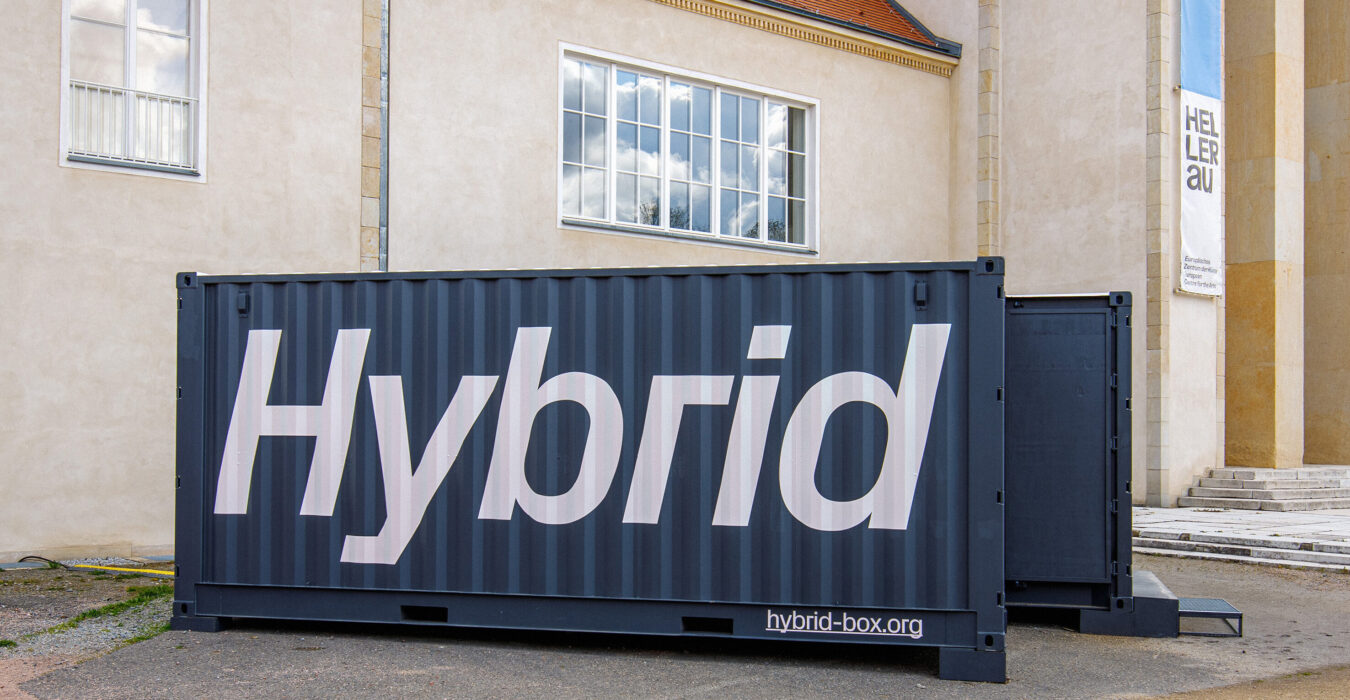
And darkness arrives early,
but who is there to witness.
The approaching shadows play,
a gentle dance of planets.
The three-channel video installation „Silent Echoes“ deals with the effects of the climate crisis. Poetic contributions by poets and activists, all of whom come from different islands in the Pacific Ocean, shed light on how the climate crisis is unfolding on these islands through the impact of (neo-)colonial practices in the past and present: Due to water contamination by military remnants from World War II, deforestation of native, forests and the planting of endless palm tree fields for the production of palm oil, the suppression of the indigenous people’s language and culture by the colonial settlers or the nuclear tests conducted on the atolls with any regard for the people living there. Digitally generated images show melted, sunken or eroded objects as silent echoes of a past in which the current course of history has not been halted.
Biography
Dorine van Meel is a Dutch artist who is internationally active in video and performance art. By combining digitally constructed image sequences, recorded sounds and the spoken word, she creates total works of art with their own aura that captivate visitors. „Silent Echoes“ is developed in collaboration with sound artist Sami El- Enany. The project includes contributions by artists, writers and climate activists Khairani Barokka, Jamaica Heolimeleikalani Osorio, Selina Neirok Leem and Dorine van Meel. „Silent Echoes“ has received financial support from the Mondriaan Fonds.
Credits
HYBRID establishes a new international platform for the arts in the digital age and critical phases of global transformation processes, funded as part of the alliance of international production houses by the Federal Government Commissioner for Culture and the Media. As a modular gallery, HYBRID Box presents experimental and interdisciplinary art by local and international artists in cooperation with and curated by PYLON.
The exhibition Silent Echoes is presented by PYLON and is funded by the Kulturstiftung des Freistaates Sachsen. This measure is co-financed by tax funds on the basis of the budget approved by the Saxon State Parliament.
In the multimedia installation HIGH NOON (2021), a discarded engine part of the former US McDonnell Douglas DC-10 aircraft creates an infinity and limitation of space and resources. On one side of the aircraft part, a video projection is shown in which image sequences of a launch of a US carrier rocket in 2021 on its way to the International Space Station (ISS), with objects and products of a contemporary throwaway society in interaction with a protagonist in space overalls, create an idiosyncratic collage of imagery. Out of a brush stemming from a former car wash a text written by the artist herself can be heard, which poses equally fragmentary questions about what remains on Earth as a technological legacy and what relics can already be expected in the universe before the expansion into space. The installation almost looks like two sides of a coin, but the front side of the object creates a seemingly infinite space through endlessly repeating lines of text.
For the installation in the HYBRID Box, a version of HIGH NOON adapted to the space will be shown. A discarded part of a Douglas DC-6 aircraft becomes the illusion of a text tunnel extending into the space. HIGH NOON (2023) thus conveys the impression of a further dimension of perception, an apparent entrance into another reality.
Biography
Catharina Szonn (*1987 in Großenhain) studied at the Offenbach University of Art and Design, the Iceland Academy of Arts Reykjavik and the Academy of Fine Arts Vienna. Her expansive installations poetically pose questions about the relationship between man and machine, progress and transience. The boundaries to philosophical themes, text and language are fluid in her mode of expression. Her works have been shown in various exhibitions, such as the Kunstverein Konstanz, the Frankfurter Kunstverein, the European Media Art Festival in Osnabrück, the Haus der Kunst in Munich and the Museum Goch.
The video diptych “After-image #2” is a poetic narrative, a fable about the history of seeing, a story of parallel time and space. Tania Gheerbrant immerses herself in the history of cinema and resurrects two historical male protagonists from the world of vision and the prehistory of cinema in her work: Jan Evangelista Purkyně (discoverer of eye-lighting) and Étienne- Gaspard Robert (inventor of phantasmagoria). The protagonists of the two videos are transformed into female or androgynous/genderless zombie figures, associated with or alienated from human and non-human species, gathering in their appearance all the symptomatic symbolism of the post-human and non-masculine gaze.
With this diptych, where each video is dedicated to the history of one of these figures, Gheerbrant enters into the dialectic of the history of memory and offers a subjective vision that mixes with dreams and poetry. It is a reflection on the role of art in theoretical research, a position that oscillates between memory and history. Images reminiscent of 19th century romantic painting and virtual 3D views make the videos a “playful shield” that allows the protagonists to navigate through this semi-mortal still life and between different narrative threads to gain new stories.
Biography
Tania Gheerbrant is a visual artist who graduated from the Beaux-Arts de Paris in 2017. In her work, she questions the way images and texts are constructed and permeate us through language, social relations and technology. Philosophy, psychoanalysis, cinema or society and its techno-liberal currents are both the scenaristic material and the background themes of the fictions at the heart of her work. These are constantly characterized by a movement oscillating between construction and deconstruction. The fascinating and ambivalent spaces she creates in her artistic work can thus be seen as poetic spaces of social and political negotiation.
Gheerbrant is a laureate of the residency program at the Cité Internationale des Arts (2020-2021), the Prix des Amis des Beaux-Arts (2021) and a participant in the Orange Rouge program (2021 season). She is also a co-founder and active member of the artist-run space in.plano on Île-Saint-Denis. She has presented her work in a solo exhibition at the Cité internationale des Arts in Paris, a duo exhibition at the Czech Cultural Center and in various group exhibitions in France and abroad: Palais des Beaux-Arts de Paris, Galerie Jeune Création in Fiminco, La Panacée MoCo in Montpellier, The Other Art Fair in Turin and the Salon de Montrouge, to name but a few.
„The Irresistible Powers of Silent Talking“ (2021) is a multi-media installation investigating automated deception recognition systems and their use in border surveillance. It is based on the iBorderCtrl algorithm which was developed to scan the facial micro-expressions of migrants entering the EU. After a person has first been interviewed by the virtual avatar, iBorderCtrl determines the level of their veracity using an undisclosed set of criteria. Essentially, it makes decisions based on algorithmic assumptions about truth or deceit.
In „The Irresistible Powers of Silent Talking“, this system is recreated and put under duress itself. In the installation, a re-modelled iBorderCtrl avatar is rendered voiceless and is placed within a speculative digital environment. The algorithmically generated multi-channel sound responds to the micro-expressions of the avatar. It maps supposed verity deviations with responsive changes in sound frequency and amplitude.
Biography
Andrius Arutiunian (b.1991) is an Armenian-Lithuanian artist and composer based in Paris and The Hague. Arutiunian works with hybrid forms of music through sound installations, film, sculpture and performances. Alternate modes of political and musical organization, sonic dissent, and playful investigation of esoteric and vernacular histories form Arutiunian’s most recent works. Through aural cosmologies, use of non-western tunings and musical systems, as well as extensive studies of resonance and speculative instruments, the artist works with sound as a world-ordering method. The imperialist histories of what we consider as “being in tune” is a recurring theme in Arutiunian’s works.
Solo shows include the 59th Venice Biennale, Pavilion of Armenia, Gharīb (Venice, 2022); Diaphonics at Centrala (Birmingham, 2023), and Incantations at CTM/silent green (Berlin, 2021). Other group shows and performances include Le Fresnoy (Tourcoing), Stroom (The Hague), Survival Kit 13 (Riga), documenta 14 Parliament of Bodies (Kassel), FACT (Liverpool), Rewire Festival (The Hague), and Contemporary Art Centre (Vilnius), as well as residencies at Cité Internationale des Arts Paris, EMARE/EMAP Liverpool, Amant Siena, BALTIC Centre for Contemporary Art Gateshead, and ZKM | Centre for Art and Media Karlsruhe. Trained as a composer, Arutiunian studied music composition and sonology at the Royal Conservatory The Hague.
Credits
The installation has first been commissioned by the FACT Liverpool, EMARE/EMAP, it was also made with the support of Hertz Lab and ZKM | Center for Art and Media Karlsruhe, BALTIC Centre for Contemporary Art, Gateshead, The Creative Industries Fund NL, and Stroom Den Haag.
The four-channel video installation foregrounds characters that normally take a back seat in video games: NPCs (“non-playable characters”) are non-playable characters that populate hyperreal worlds to create the appearance of normality. Normally, these digital extras do not play a major role in the story of the game in question. In Hardly Working, however, a washerwoman, a stablehand, a street sweeper, and a handyman from the computer game “Red Dead Redemption 2” become the main characters. With ethnographic precision, the four films observe their daily work: a rhythm of endless loops that makes them work daily and tirelessly.
Following Hannah Arendt’s description of the “animal laborans” – as opposed to the acting subject – the NPCs as individuals are an exaggeration, as their work merely manifests their status. NPCs perform so-called “surrogate actions” that provide no further social benefit. Rather, their actions are performed and enforced for the sake of appearances, thus maintaining a social order. NPCs are digital Sisyphus machines that have no perspective of breaking out of their action loops. In the moments when the algorithm of their existence shows inconsistencies, the NPCs break out of the logic of that total normality and show their own defectiveness, thus appearing touchingly human.
About the artists
Total Refusal, a collective of artists, researchers and filmmakers Susannna Flock, Adrian Haim, Jona Kleinlein, Robin Klengel, Leonhard Müllner and Michael Stumpf, intervenes as a pseudo-Marxist media guerrilla in current video games and publishes texts about games and politics. The open collective critiques existing games practices and opens a new perspective on the genre with tools of appropriation and repurposing of game resources.
Since its inception in 2018, the collective’s work has won numerous awards and been presented at more than 130 international film and video festivals and numerous exhibitions, including Berlinale, BFI London, Doc Fortnight at MoMA, NY, HEK Basel, Ars Electronica, and Venice Biennale 2021.
Credits
Text, direction and concept: Susanna Flock, Robin Klengel, Leonhard Müllner, Michael Stumpf
Music: Adrian Haim
Narration: Jacob Banigan and Lorenz Kabas
Lead Editing: Robin Klengel, Additional Editing: Susanna Flock, Leonhard Müllner
Camera: Robin Klengel, Leonhard Müllner
Modding: RCPisAwesome
Cast: A_F_M_Asbtownfolk_02 as “The Street Sweeper”, A_F_M_SDSlums_02 as “The Laundress”, A_M_M_NBXDockworkers_01 as “The Carpenter”, A_M_M_VALLaborer_01 as “The Stablehand”.
The work was realized as part of the European Media Art Platforms Residency Program at Werkleitz with support from the Creative Europe Culture Program of the European Union and in co-production with Kunsthaus Graz. Co-financed by Land Steiermark and the Kunstraum Steiermark Stipend.
The installation “Dual” is an artistic interpretation of infinite quantities in mathematics. Media artist Robin Woern translates the fact that an infinite set of numbers spans between zero and one into a differentiated aesthetic form. Two cylinders open up a visible space in between. The idea that an infinity can lie in this limited in-between, however, remains abstract.
The installation is completed by electronic sounds of the Dresden artist Jacob Korn (Uncanny Valley). Minimalist composition and the simplicity of the sculpture mirror each other, creating a spherical, artificial-looking environment.
Duration of the installation: 06.07. — 04.09., open daily 15:00 — 21:00 h
About the artist
Robin Woern (*1993 in Böblingen) is a media artist and designer. He studied communication design at the HfG Schwäbisch Gmünd and visual communication at the UdK Berlin. He currently lives and works in Berlin and is also a master student of Prof. Carsten Nicolai at the HfBK Dresden. In his work he deals with the visualization of data, noise and (non-)human interactions.
Credits
Music:
Jacob Korn – Dual I [13:04] Stereo File, 2023
Jacob Korn – Dual VI [04:18] Stereo File, 2023
Support:
Georgianna Manafa, Luisa Roth, Thomas Schmelzer, Ralf T., Niklas Thran
The exhibition is presented by PYLON and is sponsored by the Cultural Foundation of the Free State of Saxony. This measure is co-financed by tax funds on the basis of the budget passed by the Saxon state parliament.
HYBRID Box presents „Sunken Cities“, an immersive video installation by Lithuanian artist and filmmaker Emilija Škarnulytė. In a deserted landscape appears the mythological figure of the siren, who „stands for the magic and mystery of quantum mechanics“ (Roger Penrose) and acts as a mediator between nature and technology.
The mermaid gives the impression of having returned from the future to explore sunken cities and technological ruins. The video work creates a retro-futuristic view of our planet, a perspective from a time when humans are already extinct and nature has taken over – or as Škarnulytė puts it, „the ruins of human activity seen from a distant future“.
In a combination of documentary and fiction, Škarnulytė reflects on the invisible relationships between the physical world and our social imagination. In this way, it directs the viewer‘s attention to the immediate present and the imminent ecological challenges as well as the question of the future of our species.
Duration of the installation: 16.06. – 02.07., one hour before and after the events in the Festspielhaus.
About the artist
Škarnulytė received a Bachelor’s degree from Brera Academy of Art in Milan and has a Master’s degree from Tromsø Academy of Contemporary Art.
She is the winner of the Future Generation Art Prize 2019 and represented Lithuania at the XXII Triennale di Milano. In 2018, she was part of the Baltic Pavilion at the Venice Architecture Biennale. In addition to solo exhibitions at Tate Modern (2021), Kunsthaus Pasquart (2021), Den Frie (2021), National Gallery of Art in Vilnius (2021), CAC (2015), and Künstlerhaus Bethanien (2017), she participated in group exhibitions at Ballroom Marfa, Seoul Museum of Art, Kadist Foundation, and the first Riga Biennale. In 2022, Škarnulytė participated in the group exhibition Penumbra, organized by Fondazione In Between Art Film on the occasion of the 59th Venice Biennale. Her numerous awards include the Kino der Kunst Project Award, Munich (2017), the Spare Bank Foundation DNB Artist Award (2017), and the Lithuanian National Art Award for Young Artists (2016)), and she has currently been nominated for the Ars Fennica Art Award 2023. Her films are in the collections of the IFA, the Kadist Foundation, and the Centre Pompidou, and have been shown at the Serpentine Gallery (UK), the Centre Pompidou (France), and the Museum of Modern Art (New York), as well as at numerous film festivals, including Rotterdam, Busan, and Oberhausen. She recently completed residencies at Art Explora and Cite des Art, which followed another significant residency at the MAK Center for Art and Architecture. She is co-founder and currently co-director of Polar Film Lab, a collective for analog film practice in Tromsø, Norway, and a member of the artist duo New Mineral Collective, recently commissioned by the inaugural Toronto Biennial with a new body of work.
Credits
The exhibition is presented by PYLON and is sponsored by the Cultural Foundation of the Free State of Saxony. This measure is co-financed by tax funds on the basis of the budget passed by the Saxon state parliament.
In her work, video artist Eli Cortiñas uses found material from films, YouTube videos, advertisements, animations, and image archives, which she multiplies, rhythmizes, and re-scores. In the visually powerful video essay Walls Have Feelings (2019), she explores concepts of labor and value creation, among others. Cortiñas creates a dystopian image of our present that links historical, political, and aesthetic aspects. In doing so, the artist questions architecture as a manifestation and instrument of political power, as well as the role of supposedly innocent objects and interiors in their function as silent witnesses, preservers, and amplifiers of power.
Duration of the installation: 12.05. – 11.06., one hour before and after the events in the Festspielhaus.
“opera – a future game” is an interactive, digital music theater video game essay in a game engine, based on the opera “opera opera! revenants&revolutions” directed by Michael zur Mühlen, with music by Ole Hübner and texts by Thomas Köck.
The narrative starting situation could hardly be more topical: Far in the future and after a severe catastrophe, a choir with partial amnesia finds itself in conversation with itself and a cyborg. Hauntings, individual as well as collective memories of real and longed-for events rise from their cloudy memories. Suddenly they find themselves in the desolate cultural landscape of an abandoned and decaying opera stage, and the choir thinks it finally knows who it is: a rebellious choir in the middle of a Grand Opéra that is said to have sparked a revolution and the founding of Belgium in 1830. Where to put these historical turning points and utopian longings in the face of a present that thinks of the future only as catastrophe?
For the opening of the experimental video game installation on 24.03.23 in the HYBRID Box, the first game of the experimental video game installation will be played live in the large hall in front of and with the audience as a scenic gaming performance together with the author Thomas Köck.
Duration of the installation: 24.03. – 07.05., one hour before and after the events in the Festspielhaus.
HYBRID establishes a new international platform for the arts in the digital age and critical phases of global transformation processes, funded within the framework of the Alliance of International Production Houses by the Federal Government Commissioner for Culture and the Media.
Federal Government for Culture and the Media.
HYBRID Box is a project in cooperation with HELLERAU – European Centre for the Arts and PYLON curated by PYLON with the support of GRAFT Architects.
Technical direction: Tobias Blasberg
Production management: Michael Lotz
